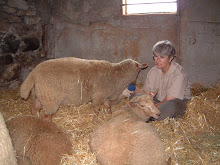I don’t know how many times I have told clients that not
only do we sell lamb but we also sell hogget and mutton just to have them
reject the mutton immediately even though the majority have never tasted it. Even
fellow shepherds often do not consider mutton as a viable product line. This article is my argument that older
animals not only can provide high quality meat with a strong market but sale of
mutton can bring in a good revenue stream and can contribute in a meaningful
way to flock improvement.
To make sure all readers understand what I mean by these
different meats from sheep, lamb is from an animal under one year of age,
hogget is from an animal between a year and two years of age and mutton is from
an animal over two years of age.
First I would like to discuss numbers. A quick tally of all animals passing through
Ontario sale barns shows that nearly 30% are mature sheep approximately 50,000
animals. A recent article in the Toronto
Star stated that Mr. Greek, a large Toronto butcher, processes close to 200
mutton animals a week. If you
extrapolate that to either the Canadian or American market you are talking a
very large numbers. This is not a niche market but rather a mainstream
market that seems to be forgotten. Consider if you could increase the revenue
from one third of your flock. This is not potential income that should be
dismissed.
As populations within the world move and countries become more diverse, we, as shepherds need to
consider not only a diversified client base but also a client base that wants
an expanded product line that includes mutton.
It is not only up to the individual shepherds but also up to marketing
boards and industry organizations to proactively grasp the opportunity to
develop and expand these markets for the benefit of producers.
Industries often fail because they are very narrow in their
focus. For example, the movie industry
suffered when television entered the market.
Their focus was narrowly aimed at the production of movies rather than a
broader focus of entertainment.
Shepherds likewise can get stuck in the narrow focus of lamb production
rather than looking at production of high quality food. There are other product lines possible beyond
that but that is for a different article.
In 2004, HRH the Prince of Wales launched Mutton Renaissance
(http://www.muttonrenaissance.org.uk/)
to re-establish the market for mutton on dinner tables in the United
Kingdom. The organization set production
and processing standards to ensure the consumer had access to a quality
product. And I meant to say re-establish
the market for mutton because this meat was a staple in households in the
United Kingdom until quite recent times.
All you need to do is look at first class menus from passenger ocean
liners from less than 100 years ago to see mutton commonly served. This movement is a fine example of what we
can do to improve both the reputation and subsequently the market and the
revenue from mutton.
Our own operation is tiny by today’s flock size averages but
we have always considered marketing mutton as part of our farm product line and
revenue stream. We have advertised,
introduced the uninitiated and marketed our mutton with the same effort as we
do our lamb. As a result, we are able
with very little effort sell all we produce. We do ensure that the quality of our mutton is
equivalent to the quality of our lamb. Mutton graces our own table more often
than lamb and I can truthfully tell our clients that mutton will be a delicious
addition to their menu. The revenue we get from mutton sales is much better
than if we shipped these animals to the sale barn.
At the beginning of this article I mentioned that sale of
mutton is integrated into our flock improvement plan. If our market was exclusively for lamb, we
would be doing the numbers game on maximizing the number of lambs we ship to
market and would probably be keeping ewes for production that we currently are
shipping for meat. Because we have a
good revenue stream for mutton, we have made our culling criteria more
stringent allowing us to improve the quality of our breeding animals at a
faster rate than if those ewes remained in our flock. As time goes on our culling criteria has
become more focussed. Would some of our
culls make good breeding stock in other flocks…. Probably but now we get more
income from them as mutton.
So where do we go from here?
First shepherds need to look at production of mutton as a separate
product line not as a discard. The breed
and marketing organizations need to expand their focus to include mutton,
hogget and lamb and the industry needs to embrace entering the market in value
added products with these meats. If it
has not already been defined, the production standards for the different
consumer markets need to be identified and voluntary standards set to meet
these markets. Shepherds need to be educated in ways to meet these standards. Processors
need to be educated on the preferred methods of handling mutton. The consuming
public needs to be re-educated about the quality and merits of mutton as a
delicious alternative to their diet reversing the negative reputation of this
meat. At the same time the consuming
public that already wants this meat should have improved access not only
through private sales but also through mainstream markets. When was the last time you saw mutton for
sale in a mainstream grocery store?
My main goal for this article is to encourage shepherds to
explore the opportunities with expanding into the mutton market and hopefully
increase the revenue stream from a significant percentage of your flock.
Laurie Maus
Hawk Hill Farm

